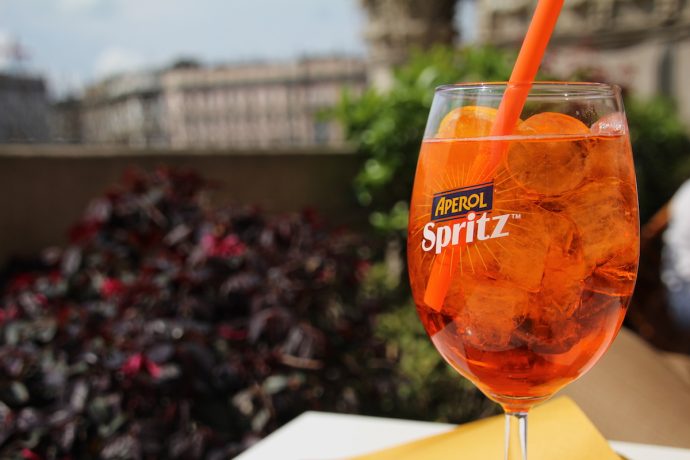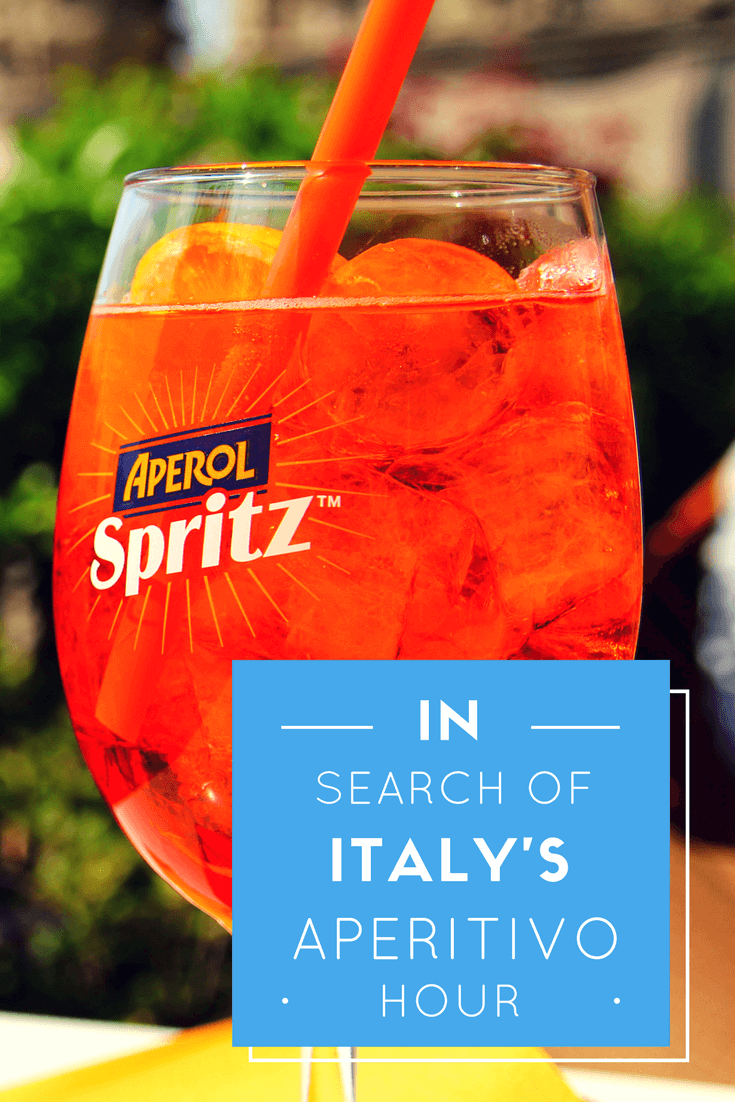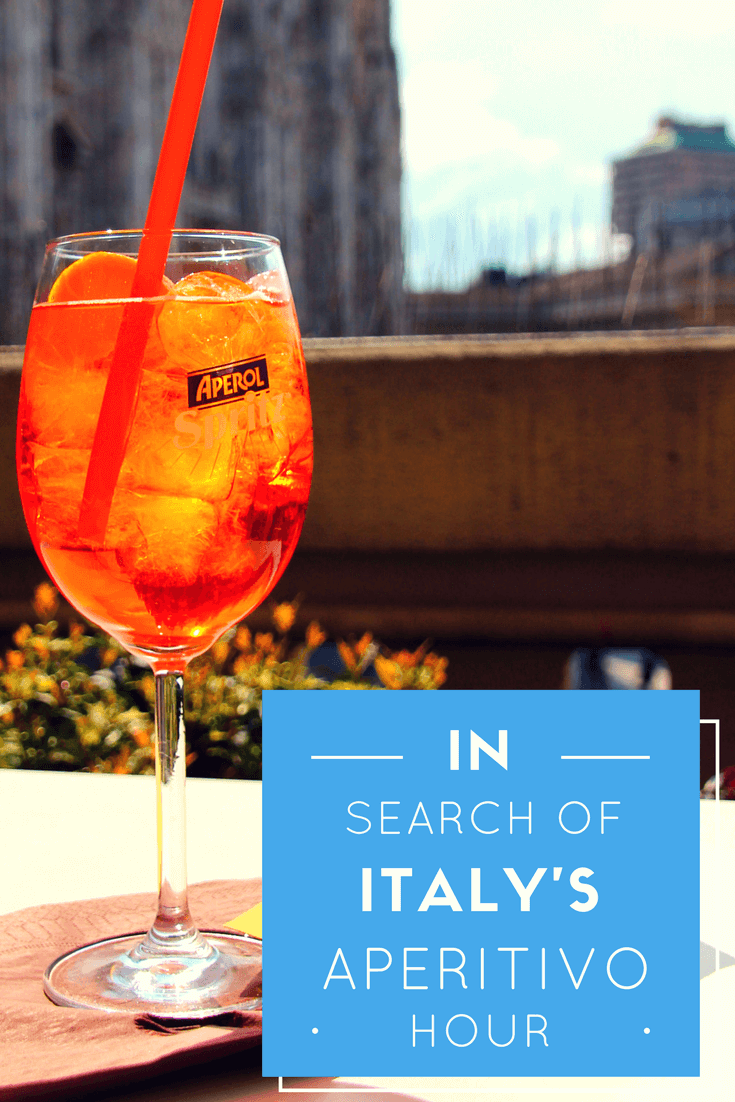Is aperitivo hour real? That time of day when Italians, collectively, adjourn to their nearest bar or cafe to enjoy a cold spritz with friends and co-workers. Can that, truly, be a thing? And if so, how do I partake?
I’d been fixated on the idea of drinking too many Aperol Spritzes in Italian cafes staffed by waiters in white jackets and black bowties since reading Spritz by Talia Baiocchi and Leslie Pariseau. This wonderful little book, which gives context to the Italian drinking tradition and collects some of its best recipes, led to the mixing of many Negroni Sbagliatos and Bicicletas in my own kitchen.
And given the rise of aperitif-style cocktails and lower-alcohol drinks across the country, the spritz category in general is enjoying a renewed interest.
But declaring a personal aperitivo hour in Boston, Massachusetts, isn’t quite the same as joining a communal one in Turin, Italy. While I harbored aspirations to make it over to the boot and experience it first-hand, I also questioned its reality. Were Italians in 2017 really skipping straight from work to quaff spritzes in smoky cafes with gratis finger-food buffets? Or would expecting such a thing be just another tourist delusion, like expecting to see wooden shoes in Amsterdam?
When my younger brother gave word that he would be attending Milan’s annual design show this past April, The Salone de Mobile, and found some seriously cheap flights, I jumped at the chance to join him and find the answer.
I arrive in Milan with targets picked out, helped by Spritz and some online research. Bar Basso, the birthplace of the Negroni Sbagliato, and Terrazza Aperol, a swanky rooftop spot operated by the liquor brand itself, were at the top of my list.
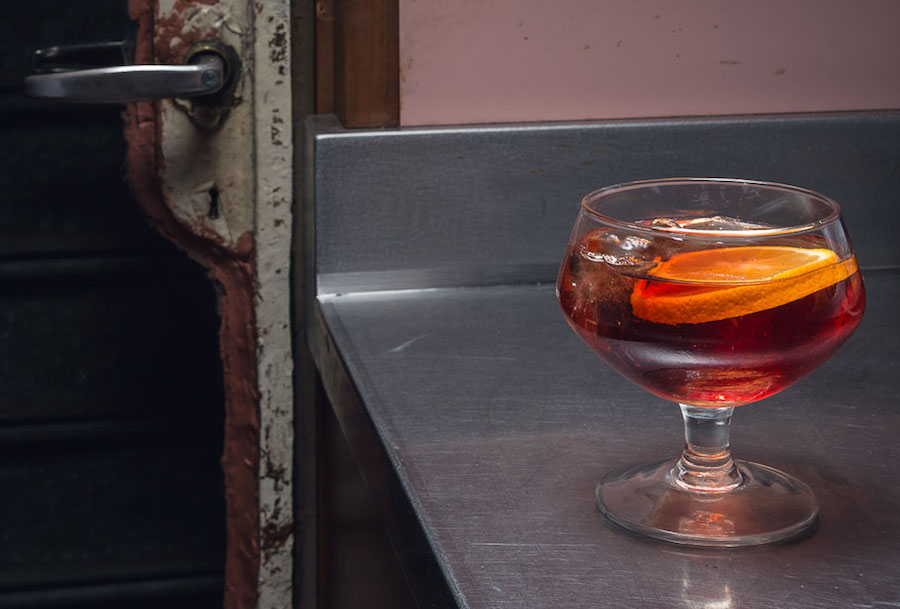
Negroni at Bar Basso
It Begins With an Aperol Spritz
The bar that ends up hosting my first aperitivo hour experience is entirely absent from that list. Down the street from my Airbnb is a small shop with a bright pink sign advertising the sale of train tickets, lottery tickets, and tobacco. Two tables with cheap plastic chairs sit outside the shop, one occupied by young Italian men smoking cigarettes and drinking Heineken.
It was, for all appearances, a shabby corner convenience store, aside from one small detail: a lit neon sign in the window announcing “aperitivo.”
I walk in to discover an actual bar nestled among the video poker machines and potato chip racks. The humble bar hosts spirits rarely seen outside of quality cocktail spots in the United States: Zucca, Cynar, and, of course, Fernet-Branca. Strangely, I don’t spy any Campari. But I take a shot at ordering a Campari Spritz anyway.
The owner replies “Si, Campari,” but retrieves a bottle of Aperol from a cupboard below the counter. He fills a tall, long-necked wine glass with a generous amount of Aperol and prosecco, and tops it off with a small splash of soda from an already-open plastic liter bottle. Lastly, he removes a previously sliced orange out of a shrink-wrapped plastic shroud and attaches the garnish.
The Aperol Spritz I end up with is enormous. The price? Four euros.
I notice some snacks—bowls of potato chips and sliced-up croissants—laid out on the other end of the counter. I know that free snacks are a part of the tradition, yet I don’t really understand how this works. Would it be a faux-pas to dive right into the vivisected croissant? I decide to pass on the snacks, and move myself and the oversized spritz to the remaining outside table.
I take my time—isn’t that what aperitivo hour is all about?—but I don’t linger excessively. I have to get to the other side of the city where my brother, and Bar Basso, is waiting.
My experience at the lotto shop did a great deal to convince me that aperitivo hour is alive and well, and not just a warmed-over tradition trotted out at tourist destinations and swanky bars. That said, the actual Italians in the place were all drinking Dutch beer, so at this point, I’ve yet to see a native partake.
While walking to Bar Basso, I stop at the threshold of a small, upscale bar. It’s an old-timey place, full of reflective surfaces and wood. Inside I see two men in suits drinking Aperol Spritzes, and beside them are plates of snacks. But this time it isn’t just chips and pastries: there appear to be meats, cheeses, and generously-topped crostinis. I enjoy my first real sight of Italians in aperitivo hour conditions, and almost step inside to join them. But I keep walking, as I’ve already got a bar to get to.

The author drinking a Negroni Sbagliatto at Bar Basso. Photo: Ryan Twardzik.
Bar Basso
Bar Basso is the old-world ideal of an Italian bar. The inside is all mirrors, carved wood, and chandeliers. An aged waiter wearing a white shirt, black vest, and black bow tie seats us at one of the round, yellow tablecloth-covered tables that ring the outside of the bar.
It’s exactly 5pm, and we’re the first to arrive. Our initial drink is obvious: a Negroni Sbagliato, which was accidentally invented by the owner’s father in the 1970s. (The story goes that he mistakenly added sparkling wine to a Negroni in place of gin, and the resulting drink was so good that it stuck around.)
The snacks arrive immediately after our drink order is taken. There are potato chips and fat green olives, plus a small dish with focaccia squares, parmesan crisps, and mortadella-topped crostini.
The drinks arrive in large, squat vessels that more closely resemble fish bowls than drinking glasses. They’re filled with ice cubes and garnished by entire, thick-cut rings of orange that are entirely submerged in the drink. They have a strong taste of Martini & Rosso Sweet Vermouth, and don’t strike me as being too different from anything I’d make at home with the same ingredients. But their colossal size—even at 10 euros—makes for an unexpected bargain.
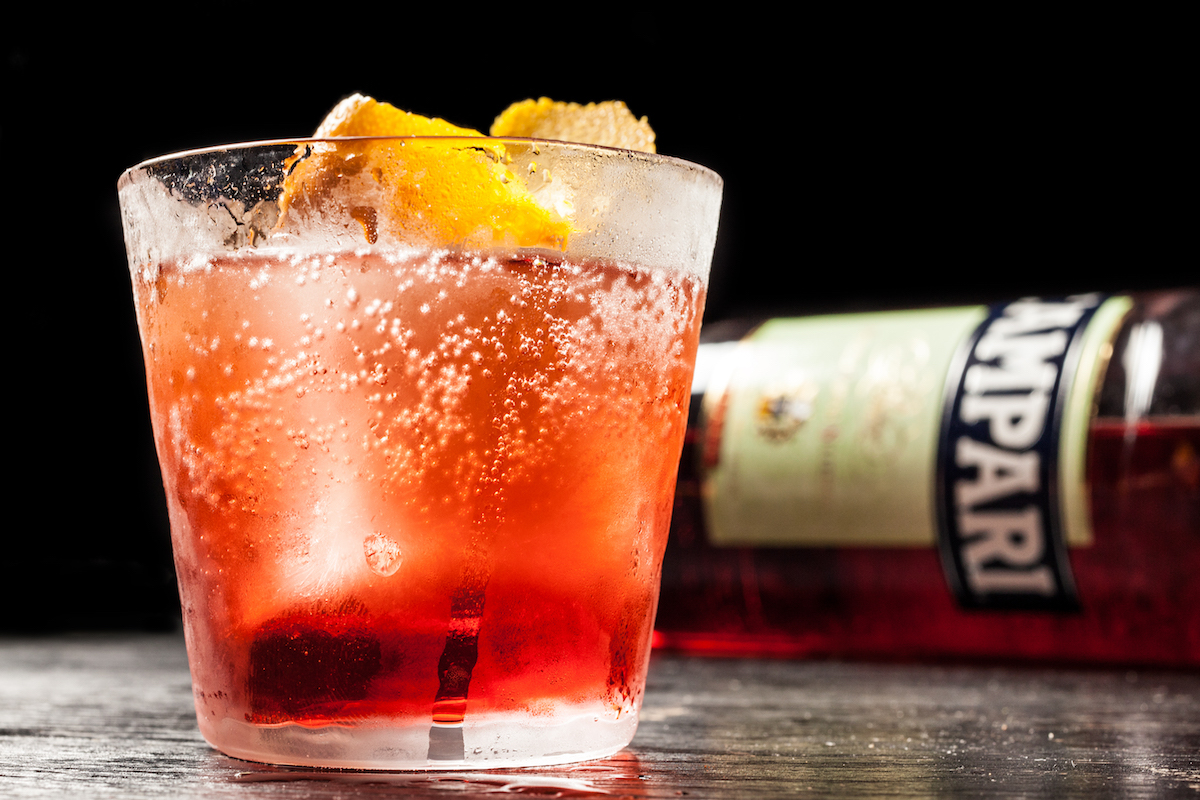
The Negroni Sbagliatto
The tables around us begin to fill. The crowd is almost entirely male, and intimidatingly well-dressed. All look to be drinking Negroni Sbagliatos or Negronis, are smoking furiously, and eating the same snacks we are.
More drinks are ordered, and more chips, olives, and crostini arrive. Hours pass, and day turns to night. Yet aperitivo hour marches on, far beyond the constraints of any natural hour. After perhaps two and a half hours we depart Bar Basso, and happily dive headfirst into the first pizza restaurant we find.
Terrazza Aperol
At 11:30am the next day, we’re seated in the sunshine, in hyper-modern outdoor chairs painted a distinctly familiar shade of orange. Terrazza Aperol is located on a roof terrace directly across from Milan’s imposing Duomo, and it would be hard to find better real estate in the city. But great real estate has a tendency to play host to mediocre, overpriced cocktails, particularly in Europe.
The too-perfect location gives me reason to worry, but the drink menu raises my spirits. It is divided into “before” and “after’ drinks, revealing a wonderfully Italian, meal-centric view of the world. The list is distinctively Aperol-heavy, but also includes a handful of Campari-laced options.
I select an Aperol Spritz—if the classic was meant to be drunk anywhere, it’s here—and my brother selects one of the more interesting choices, the “Aperol Eros,” which is an Aperol Spritz enhanced by Angostura Bitters and Tabasco.
Both are excellent. But the most satisfying part of the experience may be the snack it’s served with (it’s nowhere before dinner, but as I’m learning, aperitivo hour has a way of occupying all the space between breakfast and a late dinner). The snack is a packet of oily, thick-cut, and freshly fried potato chips.
The terrace is surprisingly unoccupied, aside from a trio of Dutch businessmen behind us. But still there’s plenty of aperitivo hour left, and I suspect that a great deal of it will be happening at this sunny lookout later in the afternoon.
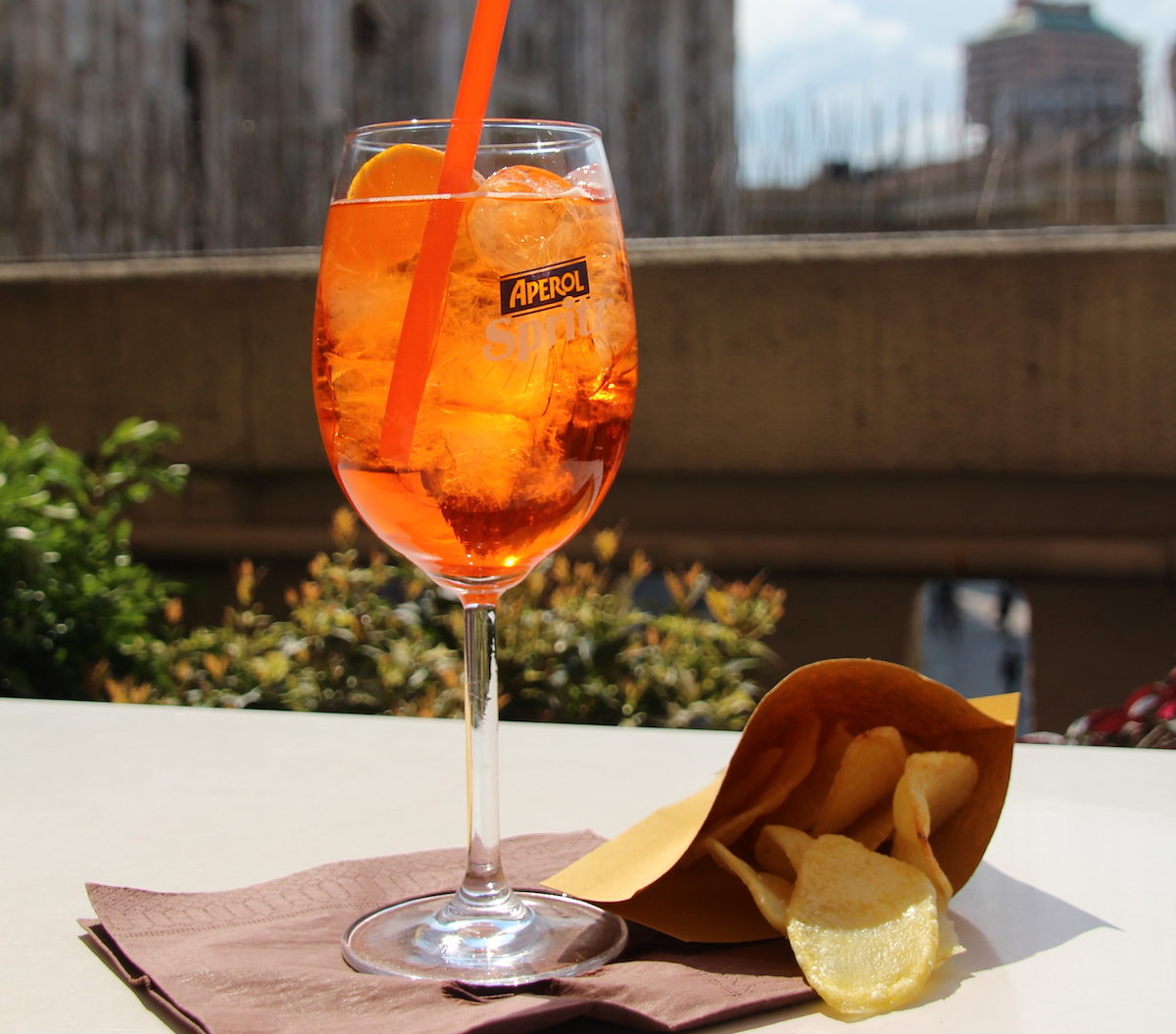
Aperol Spritz and potato chips at Terrazza Aperol. Photo: Ryan Twardzik.
On the Aperitivo Hour Trail
Our brief trip takes us south to Bologna for three days, before turning around to partake of Modena, Parma, and Milan again. We celebrate the aperitivo hour at each destination, taking note of the wildly different ways it manifests itself.
In Bologna, a standalone bar within the Mercato di Mezzo provides the best Aperol Spritzes of the entire trip, which we drink on the steps of a baroque church next door. Le Stanze, a converted chapel with a painted ceiling, offers up a sublime snack buffet with panini, pasta, curried chicken, and even pad thai. Modena’s Bicicleta Cafe sets up a DJ when the promised hour arrives, and invites patrons to construct their own bruschetta with trays of toasted bread and a tremendous bowl of crushed tomato.
We drink Aperol Spritzes out of tall, thin wine glasses at cloth-covered tables; we drink them out of little plastic cups on street corners. We drink them in quiet rooms full of old men that nod silent greetings at one another; we drink them in cacophonous bars crowded by college kids and cigarette smoke. Sometimes we soak them up with breadsticks; sometimes we soak them up with meat-and-cheese-laden crostini. But we learn that potato chips are the constant. No matter how low or how high you go, take comfort in knowing that potato chips will always be there.
Not only is aperitivo hour alive and kicking, it’s almost endless. After-lunch spritz sessions linger until they become before-dinner drinks.
A short time later, I find myself back in Boston, jet-lagged and possessing a great number of Italian cocktail napkins. There may not be a fresh spritz and a free spread awaiting me at the bar across the street, but there is a liquor store, and that store carries Aperol, Campari, prosecco… you get it.
So, sure, Massachusetts may not be Italy, but my travels have taught me that aperitivo hour can occur at virtually anytime—and anywhere. It’s a fine lesson, and one that we can all take with us, whether at home or abroad.
